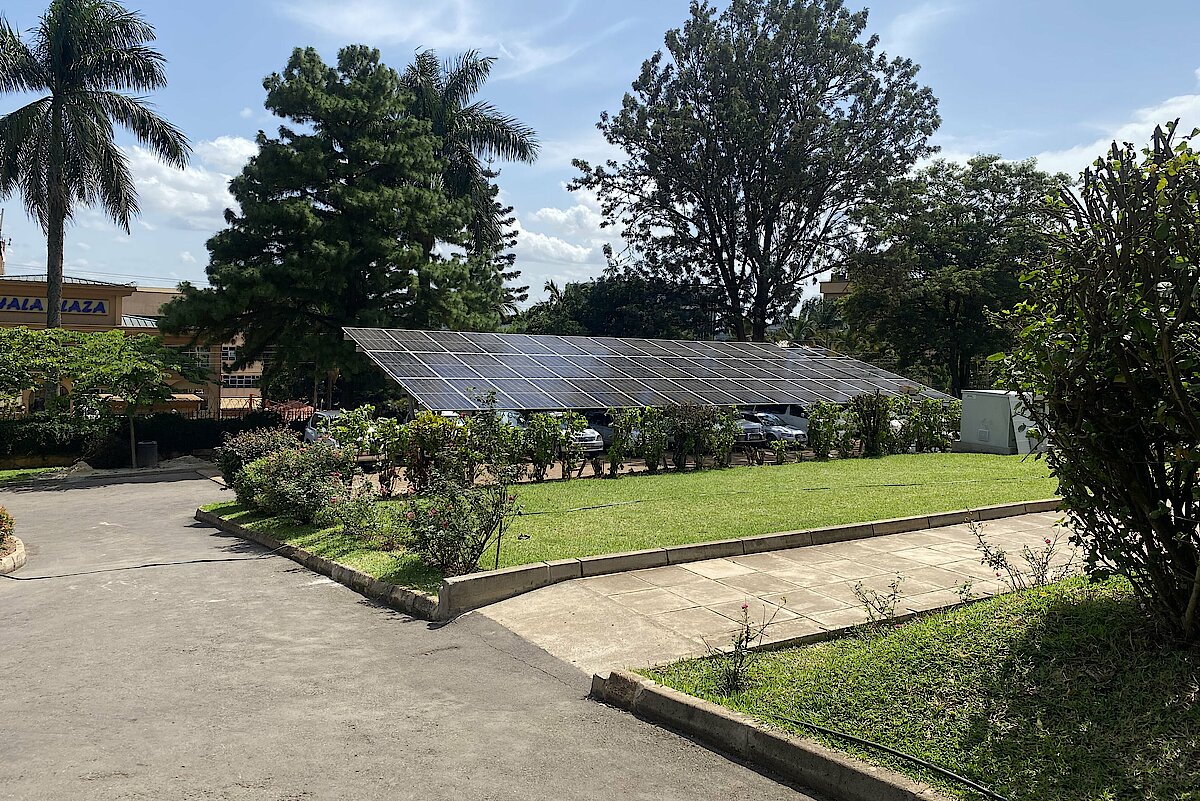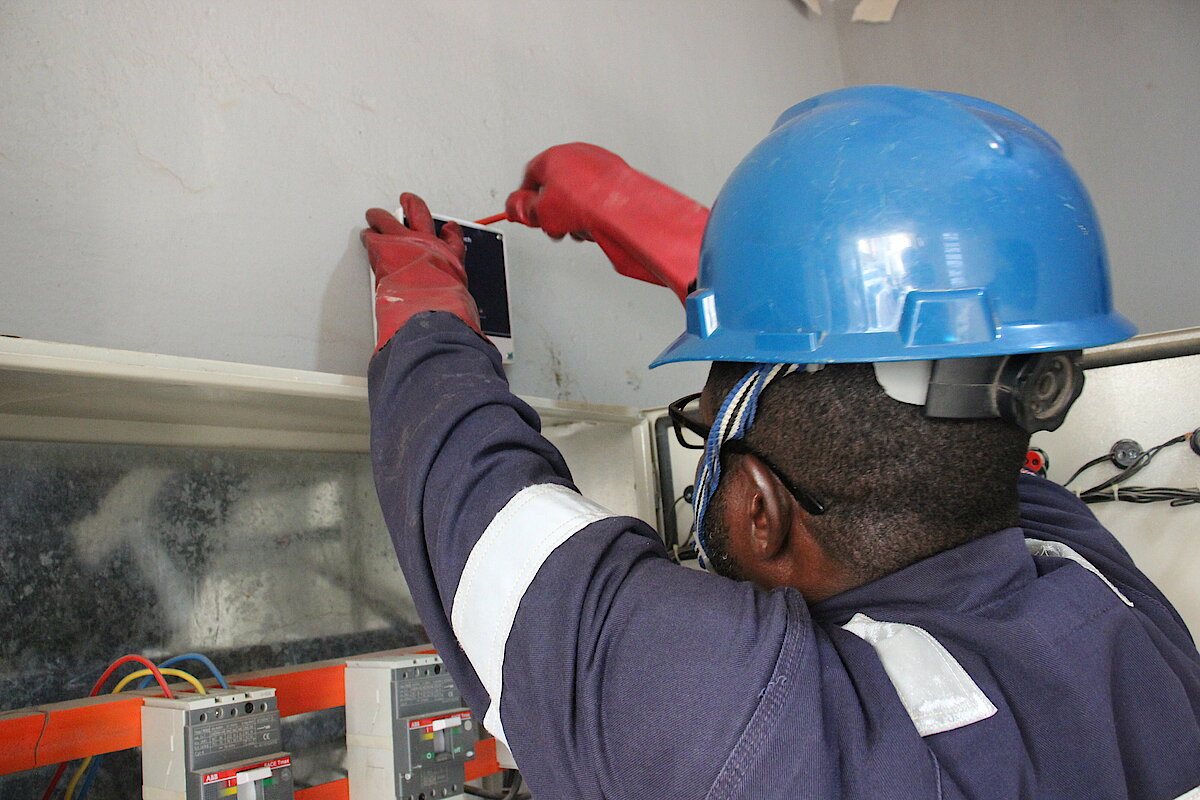Energy consumption in Germany and abroad – an overview
Protecting natural resources, including energy and resource consumption, is one of the top issues in our materiality matrix. For GIZ, dealing responsibly with the environment and natural resources is a key precondition for sustainable development. We want to do our bit and intend to reduce the energy we consume by 10 per cent per employee in Germany and by 20 per cent outside Germany by 2025 compared with 2019. To promote sustainable development, we also intend to make more use of renewable energy. How we will do so, is set out in our management approach, which is explained in the section „Enviromental management at GIZ“
Total energy consumption was slightly higher in 2021 than the previous year
The total energy consumption and the energy mix varies widely between GIZ Germany and our operations abroad. In Germany, our energy consumption figures cover mainly electricity and heating/cooling energy, whereas outside Germany a large share is also accounted for by fuel for company vehicles and generators. Total energy consumption in Germany is about 2 per cent up on the previous year. Outside Germany, it rose by about 7 percent, taking it to about 10 per cent below the pre-COVID 19 pandemic level. Total energy consumption per employee fell by 14 per cent in Germany and by 18 per cent abroad.1 This is due partly to sustainability measures we have taken, such as introducing LED lighting and making more efficient use of installed systems.
Energy consumption broken down by heating/cooling energy, electricity, generators and fuel for company vehicles
| Germany | Abroad |
|---|---|
| Electricity 40 % | Electricity 24 % |
| Heating/cooling energy 60 % | Heating/cooling energy 14 % |
| Fuel for company vehicles and generators 0,3 % | Fuel for company vehicles and generators 62 % |
Green electricity is our preferred option
Almost all the power used at GIZ locations in Germany is green electricity. In 2021, some 94 per cent of the electricity used was generated from renewables. The consumption of conventional electricity stems from the use of spaces shared with other tenants, such as reception areas and lifts in leased properties. Wherever possible, we are replacing conventional light bulbs with LEDs at all locations. We are also optimising ventilation systems to save power. The Meander Building and Campus Forum in Bonn both have a geothermal and a photovoltaic (PV) system. Electricity consumption in our locations in Germany in 2021 was roughly 7 per cent down on the previous year, whereas it rose by 10 per cent abroad. Our worldwide electricity consumption was about 11 per cent below the 2019 level.
As a general rule, we measure electricity consumption at all locations where GIZ staff work in our partner countries. Since most countries do not yet generate enough on-grid electricity from renewables, we cannot achieve the same percentage of green electricity supplied to our offices outside Germany as we do in Germany. However, we are looking at where and how it makes economic and environmental sense to use PV systems in our locations abroad. The installation of PV systems has also been included as a target in the Sustainability Programme 2021-25. Since the target was set, the number of country and project offices installing or planning to install PV systems has been steadily increasing. Energy efficiency measures are an important aspect: the lower the basic electricity demand, the better the chances of meeting demand in the event of power outages with appropriately dimensioned PV systems and also of reducing the use of diesel generators for peak loads. This is also associated with greater energy security for GIZ locations in fragile contexts. Energy efficiency and renewable energy therefore complement each other.

GIZ installed smart meters on switch boxes and diesel generators in three offices in Nigeria in 2021 with the aim of better understanding the offices’ electricity needs, i.e. the frequency and voltage of power supplied by each source. This also provided information on whether particular devices and equipment were functioning properly and as efficiently as possible. The next step will be to carry out energy audits to identify the largest energy consumers and potential savings.

The office of the Responsible Land Policy in Uganda (RELAPU) project has been operating roof-mounted solar panels in conjunction with a battery-based storage system since 2018. This has significantly reduced consumption in the Kampala office. The system also ensures that employees can continue to work in the event of power outages. All printers, office lighting and sockets for the computers are connected to the solar-powered emergency power system.
Energy consumption for heating and cooling
Energy consumption at GIZ’s locations in Germany mainly involves the use of heating and cooling energy and electricity. Heating and cooling energy alone accounts for just over half of consumption. The share of renewable energy consumption in Germany has increased significantly from about 20 to 61 per cent, as many locations have switched to using biomethane for heating. Furthermore, some sites are using geothermal heating and cooling systems.
Our locations in Germany and abroad vary enormously in terms of heating/cooling energy consumption. Overall, energy consumption for heating and cooling in 2021 was up 12 per cent on the previous year. Consumption per employee in Germany was 2,264 kWh in 2021, which represents an increase of around 10 per cent. Outside Germany, where heating is available in only a few countries or is partly based on electricity, the absolute value is lower. However, 2021 also saw an increase from the previous year: to 497 kWh per employee, which is a rise of approximately 18 per cent.
Fuel for company vehicles
The greatest difference between Germany and other countries is the direct energy consumption resulting from vehicle fuel and generators. These two factors play a secondary role at GIZ locations in Germany. Vehicle fuel accounted for 50,837 kWh in 2021 in Germany, whereas consumption outside Germany was 37,674,317 kWh. This is primarily because the number of vehicles at locations abroad is significantly higher. While GIZ had only nine motor vehicles in Germany at the end of 2020, the total for all other countries was almost 3,000, about 40 of which were fully electric or hybrid vehicles. Roughly 550 new vehicles were purchased for use abroad in 2021. The energy consumption of motor vehicles fell by about 18 per cent compared with the 2019 base year.
The COVID-19 pandemic has led to a significant decrease in fuel consumption for cars abroad since 2020. In order to keep fuel consumption low in the future, options for a company-wide vehicle pooling system are being explored. The idea is for cross-project procurement and use of vehicles to become standard practice.
Less fuel for generators
Following a significant increase in 2020, fuel consumed by generators abroad has now fallen again by about 25 per cent to roughly 11 per cent below the 2019 base year. On the one hand, this could be due to the fact that the grid power supply in our partner countries was generally more stable. Another factor could be the increasing use of solar power systems, which reduce – or even eliminate – the need to use generators. However, the supply situation remains precarious in many of our partner countries, making emergency generators indispensable. In Germany, generators are only used to supply emergency power during maintenance work on the power grid. Overall, the consumption of fuel by generators has fallen by about 11 per cent compared to the 2019 base year.
| Germany | Abroad | |||||
| 2019 | 2020 | 2021 | 2019 | 2020 | 2021 | |
| Total energy consumption | ||||||
| Total energy consumption in kWh | 24,114,794 | 22,286,638 | 22,804,765 | 80,277,407 | 66,717,089 | 71,652,144 |
| Total energy consumption per employee in kWh | 4,387 | 3,692 | 3,792 | 4,404 | 3,518 | 3,592 |
| Electricity | ||||||
| Total electricity consumption in kWh | 10,088,941 | 9,793,714 | 9,126,536 | 19,717,828 | 15,778,096 | 17,424,935 |
| Total electricity consumption per employee in kWh | 1,835 | 1,628 | 1,517 | 1,082 | 832 | 874 |
| Share of green electricity | 93 per cent | 94 per cent | 94 per cent | Data not collected in CSH | ||
| Heating/cooling energy | ||||||
| Total heating/cooling energy in kWh | 13,925,530 | 12,419,494 | 13,616,686 | 7,083,143 | 8,430,613 | 9,918,427 |
| Total heating/cooling energy per employee in kWh | 2,533 | 2,064 | 2,264 | 389 | 445 | 497 |
| Share of renewable heating/cooling energy in % | 12 per cent | 20 per cent | 61 per cent | Data not collected in CSH | ||
| Fuel for company vehicles and generators | ||||||
| Total energy consumption from motor vehicle fuel in kWh | 94,826 | 49,087 | 50,837 | 46,036,759 | 33,489,005 | 37,674,317 |
| Total energy consumption from motor vehicle fuel per employee in kWh | 18 | 8 | 9 | 2,526 | 1,766 | 1,889 |
| Total energy consumption from generators in kWh | 5,498 | 24,343 | 10,705 | 7,439,677 | 9,019,375 | 6,634,465 |
| Total energy consumption from generators per employee in kWh | 1 | 4 | 2 | 408 | 476 | 333 |
Information on the following Sustainable Development Goals (SDGs) can be found on this page:
